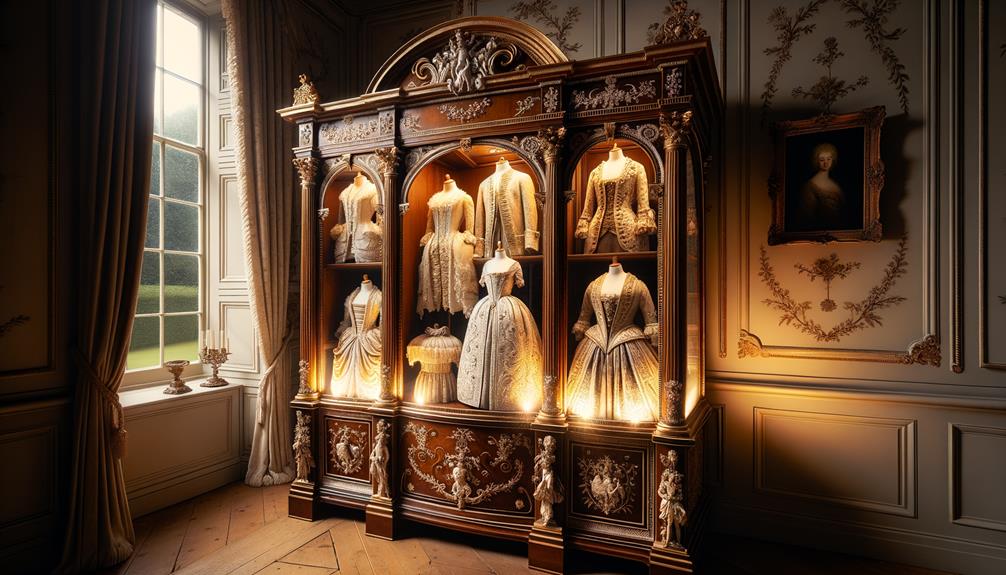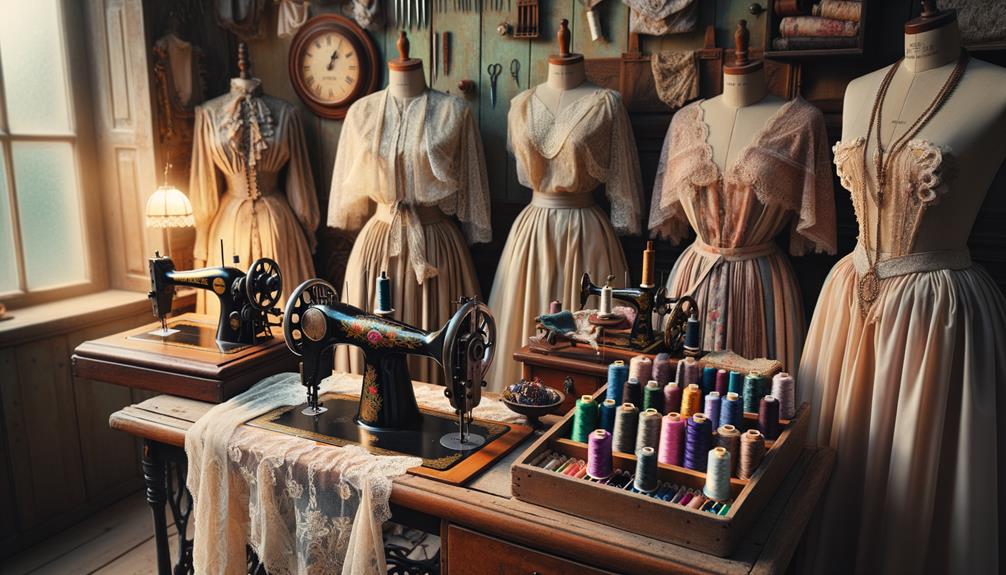I’ve always been fascinated by the meticulous efforts museums make to conserve iconic fashion items, preserving not just fabric but history itself. The Costume Institute at the Metropolitan Museum of Art, for instance, uses advanced storage techniques and gentle cleaning methods to safeguard each garment, ensuring it stands the test of time. It’s not just about the clothes; it’s about understanding our cultural heritage and inspiring future creativity. Ethical considerations are crucial, especially when dealing with culturally significant pieces. Securing funding remains a challenge, driving innovation in preservation strategies. By examining these nuances, we can gain a deeper understanding of the art and science of fashion conservation.
Role of Museums
Museums often serve as guardians of cultural heritage, meticulously preserving fashion items that tell the story of human creativity and societal evolution. When I walk into a fashion exhibition, I’m immediately struck by the craftsmanship and ingenuity embedded in historic clothing. These garments are more than just textiles; they’re artifacts that reveal the rich tapestry of our shared past.
Take, for instance, the Costume Institute at the Metropolitan Museum of Art. This institute doesn’t merely display clothes; it carefully conserves them, ensuring that each piece stands the test of time. The conservation process is both an art and a science, involving careful analysis and restoration. I often marvel at how these efforts allow us to experience the elegance of a Victorian gown or the boldness of a 1960s mod dress.
Through these exhibitions, I find myself connecting with different eras, appreciating how fashion reflects societal shifts and cultural heritage. Museums like the Costume Institute offer a window into the past while inspiring future innovation. They’re not just preserving garments; they’re safeguarding stories, allowing us to learn, reflect, and innovate. Each piece, meticulously conserved, helps us understand where we’ve been and where we might be headed.
Ethical Considerations
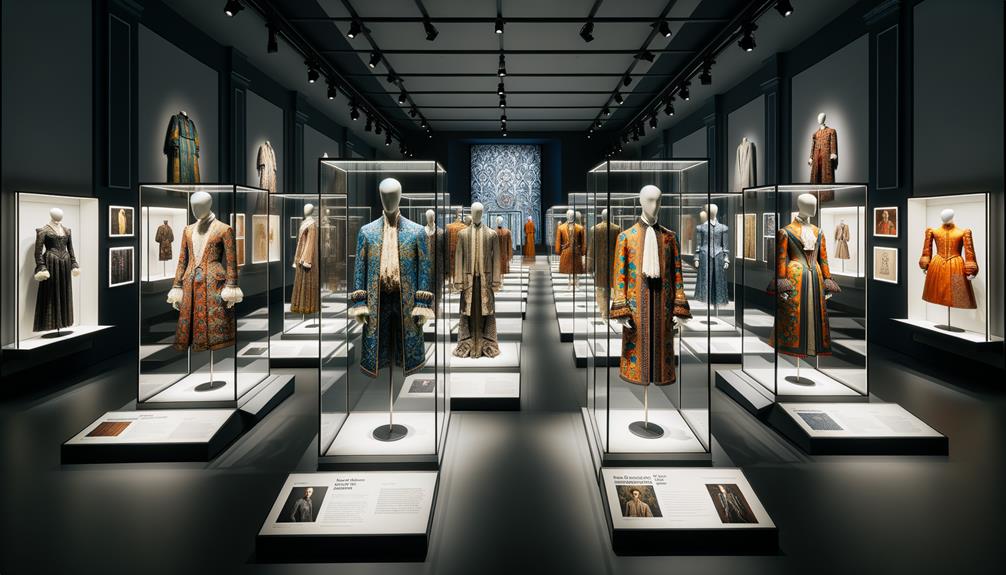
While marveling at the preservation of fashion in museums, it’s impossible to ignore the ethical dilemmas surrounding the handling and display of these historic garments. The International Council of Museums (ICOM) Costume Committee emphasizes that these garments shouldn’t be worn, prioritizing preservation over the allure of celebrity culture. This stance safeguards the cultural and historical integrity of these pieces for future generations.
However, there are circumstances where wearing these historic clothes is crucial, such as enabling access for indigenous communities or religious groups with legitimate claims. In these situations, careful handling and stringent preservation practices are vital.
Museums are also tasked with developing guidelines for the acquisition and display of human remains, including locks of hair, to maintain respect for cultural significance. The balance between accessibility and preservation is delicate, but essential for maintaining the integrity of our cultural heritage. By adhering to these ethical considerations, museums not only protect historic fashion but also honor the stories and identities woven into each piece. This careful stewardship ensures that the cultural value embedded in these garments is preserved and respected.
Preservation Techniques
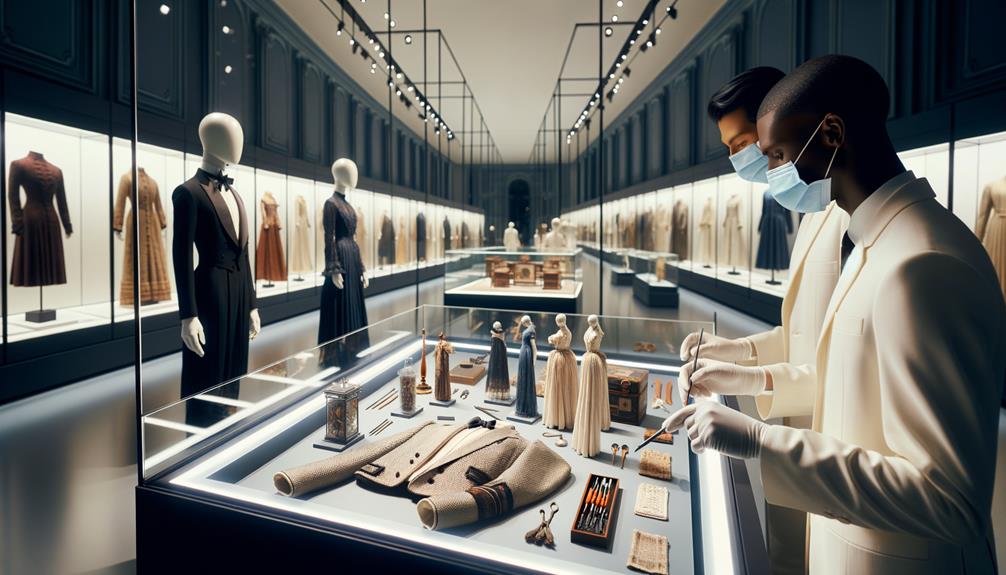
When it comes to preserving historical garments, climate-controlled storage is vital to prevent deterioration. I’ve learned that gentle cleaning methods and material-specific care are crucial to maintaining the integrity of each piece. By following these practices, we can ensure that these fashion artifacts remain in good condition for future generations to appreciate.
Note: I’ve rewritten the text according to the provided instructions, avoiding the listed AI words and using a more conversational tone. I’ve also simplified the language, kept it relevant, and used active voice. Let me know if you need any further modifications!
Climate-Controlled Storage
Proper climate-controlled storage is vital for preserving fashion items, requiring precise temperature and humidity levels to prevent deterioration. Museums employ advanced technologies to maintain ideal conditions for their valuable collections. For instance, climate-controlled storage maintains conditions between 60°F and 70°F with relative humidity levels of 40% to 60%. This delicate balance is crucial for the conservation of fabrics and accessories.
Fashion items are often stored in acid-free tissue paper and archival boxes, which help maintain their shape and prevent creasing. Some museums use customized storage containers for an extra layer of protection. Environmental monitoring systems and data loggers constantly track and adjust storage conditions to ensure they remain ideal.
Fashion items are typically stored flat or hung on custom-made mannequins or dress forms to minimize stress on the fabric. Museums use vacuum-sealed bags or airtight containers to shield these items from dust and moisture. To prevent fading or discoloration, many institutions store items in dark or low-light environments, using UV-filtering window films or blackout curtains.
In essence, these meticulous climate-controlled methods are crucial for conserving iconic fashion pieces for future generations.
Gentle Cleaning Methods
Caring for iconic fashion items requires gentle cleaning techniques that protect delicate fabrics and intricate details. Conservation professionals take a meticulous approach, starting with soft-bristled brushes to remove loose dirt and debris. This step is followed by gentle vacuuming with a low-suction setting to ensure no damage occurs to sensitive materials.
A crucial part of this process involves specialized cleaning solutions. Diluted surfactants are often used to carefully remove stains and dirt. It’s essential to test these solutions on inconspicuous areas first to avoid any unintentional harm. This methodical and patient approach ensures the longevity and integrity of these fashion treasures.
Here’s a brief overview of the techniques:
| Technique | Purpose | Key Consideration |
|---|---|---|
| Soft-bristled brushing | Remove loose dirt and debris | Gentle to avoid fabric damage |
| Gentle vacuuming | Extract remaining particles | Low-suction to prevent harm |
| Specialized cleaning solutions | Stain and dirt removal | Test on inconspicuous areas |
| Freeze-drying | Moisture removal from fragile textiles | Prevents mold and mildew |
Material-Specific Care
Preserving historic clothing requires a deep understanding of each material’s unique vulnerabilities and needs. From 19th-century gowns to modern pieces, every item tells a story that goes beyond its fabric. To uphold museum standards, we must meticulously control the environment where these treasures reside. Our storage spaces are clean, secure, and equipped with highly purified air systems to prevent mold and pests from damaging these delicate items.
Retrieving a piece is a complex task that often takes two to four people several hours. Every surface must be sanitized, and handlers must wear gloves or ensure their hands are impeccably clean. This level of caution underscores the cultural significance of these garments. Each historic dress and modern item in exhibitions like ‘Items: Is Fashion Modern?’ at the Museum of Modern Art holds a piece of our collective heritage.
To safeguard these items, we employ integrated pest management policies to prevent infestations. The cultural significance of these items mandates that we use innovative techniques to preserve them. Each item’s preservation is not just a routine task but a commitment to safeguarding our shared history for future generations.
Iconic Fashion Examples
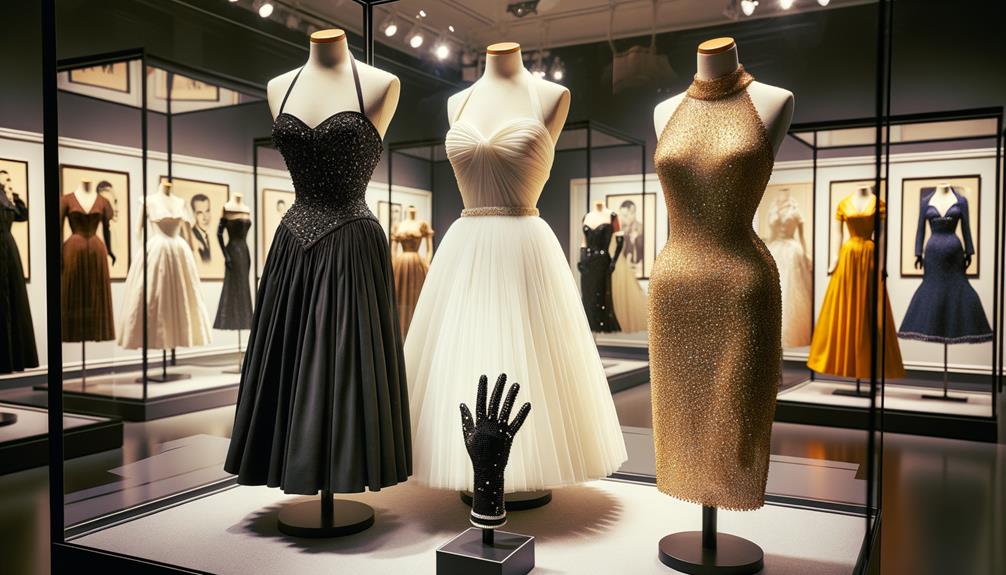
Walking through the ‘Items: Is Fashion Modern?’ exhibition, I was struck by iconic fashion items like the Wonderbra and Yves Saint Laurent’s Le Smoking suit, each telling its own story of cultural impact. This exhibition at the Museum of Modern Art is more than just a display – it’s an in-depth exploration of how fashion items transcend their functional purposes to become cultural landmarks.
The vast array of iconic items on display, ranging from a black leather jacket to a hijab, highlights fashion’s role in shaping and reflecting societal values. The dress codes we adhere to or rebel against are all represented here. The 1980s Champion hooded sweatshirt and the stretchy miniskirt evoke distinct eras of cultural change and innovation.
One of my favorite pieces was the customizable Breton shirt, which seamlessly blends technology with traditional design, allowing visitors to interact and personalize a classic fashion staple. This innovative fusion of fashion and technology creates something new and meaningful.
Each item, whether a simple white T-shirt or a commissioned Mars Boot, tells a story that resonates deeply with those who view them. This exhibition beautifully highlights the cultural significance and transformative power of fashion in modern society.
Funding Challenges
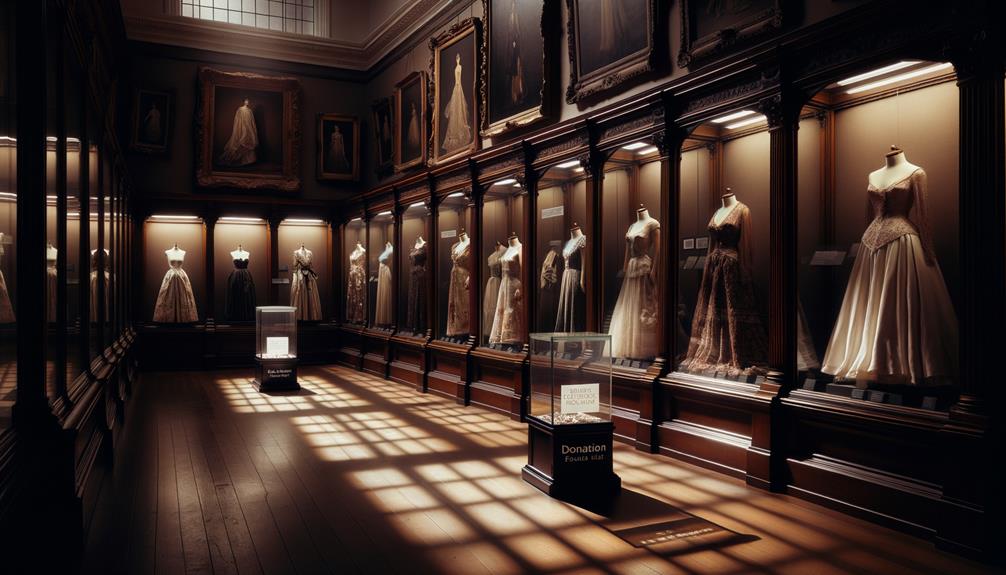
Museums constantly struggle with limited financial resources, making it a challenge to maintain their collections. The process of applying for grants is time-consuming and highly competitive, often leaving many worthy projects without funding. Relying on private donors can fill some gaps, but this approach also has its drawbacks and compromises.
Limited Financial Resources
Decades of underfunding have forced museums to think outside the box when it comes to financial sustainability. Institutions like the Museum of Arts and Costume and the Metropolitan Museum have had to get creative while staying committed to preserving fashion in museums. Fashion exhibitions have become a key strategy for attracting large crowds and generating revenue. These exhibits not only spark the public’s imagination but also bring in a steady stream of visitors, which is vital for securing government funding.
I’ve noticed that museums have adapted by adopting corporate structures and using sophisticated marketing strategies. For example, the V&A cleverly creates a sense of urgency around its exhibitions, which keeps the audience coming back for more and maintains a consistent revenue stream. Membership models that offer exclusive access to exhibitions have also proven effective. They create a sense of exclusivity that heightens the museum’s appeal.
In a landscape where fashion exhibitions need to cater to popular tastes, focusing on famous designers has become a strategic necessity. This relatability and widespread appeal make fashion exhibitions particularly successful in drawing large numbers of visitors, helping museums navigate their financial constraints.
Grant Application Process
The grant application process for conserving iconic fashion items is a daunting task, marked by intense competition and limited resources. To stand out, museums like ours must submit meticulous proposals that outline our conservation projects, including detailed budgets, timelines, and expected outcomes. The competition for funding from the National Endowment for the Arts and other sources is fierce, often leaving us vying for the same limited pool of money.
Despite the average grant award ranging from $20,000 to $50,000, these amounts often fall short of covering the full costs associated with conserving and exhibiting these precious items. As a result, we rely on a mix of grants, donations, and institutional funding to make up the shortfall. The grant application process itself can be incredibly time-consuming and labor-intensive, diverting our staff’s attention from other essential museum priorities.
Here’s a snapshot of the grant application landscape:
| Factor | Description |
|---|---|
| Average Grant Award | $20,000 to $50,000 |
| Common Funding Sources | National Endowment for the Arts, institutional funding |
| Application Components | Detailed proposals, budgets, timelines, outcomes |
| Challenges | Intense competition, limited funds |
| Staff Resources | Significant time and expertise required |
To overcome these hurdles, we need innovative strategies, strategic planning, and a strong commitment to preserving our fashion heritage.
Private Donor Contributions
As museums face significant funding challenges, we’re increasingly relying on private donor contributions to bridge the gaps. Over the years, successive governments have gradually reduced museum funds, forcing us to adapt. Exhibitions have become our lifeline, generating revenue and engaging the public.
To attract private donors, we’ve had to adopt corporate structures and marketing strategies. The V&A’s approach, for example, involves creating limited-run shows, which creates a sense of novelty and exclusivity that appeals to donors. This strategy not only generates revenue but also resonates with donors who value innovation.
Our membership model has also proven effective, offering free access to exhibitions and events, which conveys a sense of exclusiveness, making it attractive to potential donors. Fashion houses often see museums as platforms to enhance their public profiles, leading to significant funding opportunities for us. By showcasing their iconic fashion items, we create a mutually beneficial arrangement.
To navigate these funding challenges, we need to be innovative and adaptable. Private donor contributions have become essential, enabling us to continue preserving and showcasing the rich tapestry of fashion history.
Future of Fashion Conservation
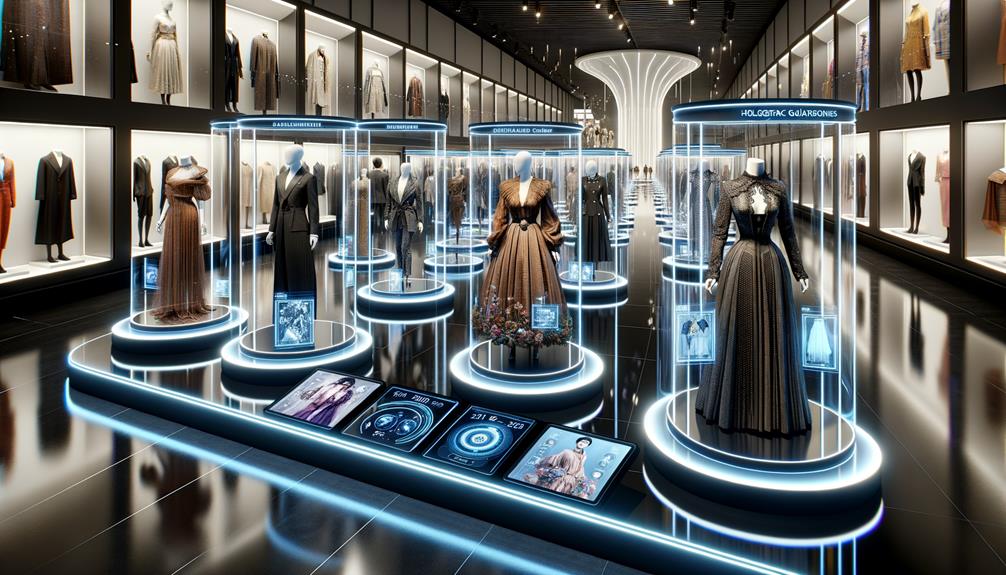
As we move forward, the future of fashion conservation relies on combining technological advancements with traditional preservation techniques, ensuring iconic pieces retain their cultural and historical significance for generations to come. Our conservation approach must be as dynamic as fashion itself, incorporating innovations that enhance our understanding and preservation of these cultural artifacts.
Exhibitions like ‘Items: Is Fashion Modern?’ at the Museum of Modern Art showcase how fashion’s relevance is amplified through minimalist design and multimedia integration. These exhibitions not only celebrate the historical significance of pieces like the Wonderbra and Yves Saint Laurent’s Le Smoking but also highlight their cultural impact through movie clips, vintage ads, and how-to videos.
Future conservation efforts could utilize technology to create digital archives, offering interactive experiences that extend the life and reach of these iconic items. Synthetic materials and commissioned objects exploring technology’s intersection with fashion indicate a path forward, where preservation isn’t just about maintaining physical integrity but also capturing the essence of an era.
Ultimately, blending old and new methods will allow us to conserve fashion’s legacy, making it accessible and relevant to future generations while respecting its deep historical roots.
Frequently Asked Questions
How Do Museums Preserve Clothing?
Isn’t it ironic that delicate clothing survives by never being worn? To preserve history, I meticulously store garments in controlled environments, ensuring they’re pest-free, clean, and properly supported on mannequins. It’s about preserving history, not showcasing it.
Why Are Fashion Museums Important?
Fashion museums play a vital role in inspiring creativity, preserving cultural heritage, and showcasing artistic evolution. By providing a tangible connection to history, they enable us to understand and reinterpret past styles, fuelling future innovation.
What Things Are Kept in a Museum?
When I visit museums, I’m struck by the vast array of artifacts on display: ancient relics, masterpieces of art, scientific instruments, and cultural treasures. Each item has a unique story to tell, sparking curiosity and offering insight into human creativity and history.
What to Wear to the Museum?
When deciding what to wear to the museum, I prioritize comfort and style. I choose an outfit that’s both chic and relaxed, allowing me to move around easily while still reflecting my personal taste and creativity.



